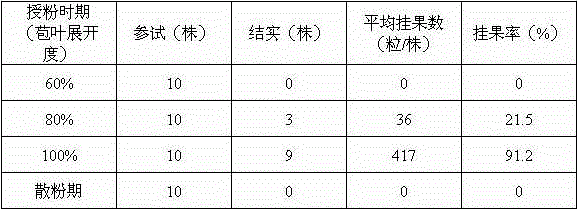Method for amorphophallus virosus crossbreeding
A technology for hybrid breeding of konjac verruca is applied in the directions of botanical equipment and methods, application, plant genetic improvement, etc., can solve problems such as failure to exert effect, short flowering period, and ineffective flowering, and achieves high seed setting rate and low cost. , the effect of less virus accumulation
- Summary
- Abstract
- Description
- Claims
- Application Information
AI Technical Summary
Problems solved by technology
Method used
Image
Examples
Embodiment 1
[0046] In 2010, 26 flowering plants of Amorphophallus konjac were cultivated in the experimental site of Dehong Prefecture Agricultural Science Institute according to technical step A (the same below); artificial auxiliary pollination was carried out according to technical step E (the same below), and 1 plant was successfully induced to bear fruit. ~6 weeks later, the scapes are as high as 91 cm, the appendages are separated from the mother body, and the later growth is normal; the remaining 25 plants will yellow and wither after 2 weeks of pollination, and the appendages will stay; in late December, the berries of the surviving plants are fully mature and red, According to technical step F (the same below), the seeds were harvested in batches and dried on the spot; a total of 418 berries were harvested. The thousand-grain weight of the berries was 286g, and each berry contained 1 to 2 seeds. In March of the following year, the seedlings were sowed according to technical step G ...
Embodiment 2
[0048] In 2011, 21 flowering plants of Amorphophallus konjac were cultivated; pollen vigor was measured according to technical step (B, the same below); pollination was carried out according to technical step (C1), and the pollination time was between 19:00 and 21:00 (below Same), respectively number the observation records (see Table 1); after artificial pollination, 4 plants bear fruit, and the material numbers are: 4, 5, 8, 20; the remaining plants yellow and wither after 2 weeks; the surviving plants in late December The berries are mature and the appendages stay in place. The seeds are harvested in batches and air-dried on the spot. A total of 1,412 berries are harvested, with a thousand-grain weight of 289g (see Table 1). Seedlings were sown in March of the following year, and 2125 seedlings were obtained; in mid-May, the field was transplanted with a survival rate of 88.3%; in mid-November, the plants fell after the seedlings were harvested and dug, and a total of 402.8 k...
Embodiment 3
[0052] In 2012, 57 flowering plants of Amorphophallus konjac were cultivated. Measure pollen vigor according to technical step (B); the first batch of flowering plants did not bear fruit after same pollination; 40 plants were selected for artificial assisted pollination experiment according to technical step (C1), with bracts spreading 60%, 80%, 100% ("Trumpet-shaped") and four treatments during the powder-spreading stage, each with 10 plants. The experimental results are shown in Table 2, the fruit hanging rate = the number of full fruit / the number of fruit. The test results show that Amorphophallus wartii pollination does not bear fruit; the bracts spread for 1 to 2 days, and the fruit setting rate is the highest; by the pollination stage, the female flowers have completely lost their vitality and cannot bear fruit.
[0053] Table 2 The morphological characteristics of konjac bracts and hybrid seed setting rate
[0054]
PUM
 Login to View More
Login to View More Abstract
Description
Claims
Application Information
 Login to View More
Login to View More - R&D
- Intellectual Property
- Life Sciences
- Materials
- Tech Scout
- Unparalleled Data Quality
- Higher Quality Content
- 60% Fewer Hallucinations
Browse by: Latest US Patents, China's latest patents, Technical Efficacy Thesaurus, Application Domain, Technology Topic, Popular Technical Reports.
© 2025 PatSnap. All rights reserved.Legal|Privacy policy|Modern Slavery Act Transparency Statement|Sitemap|About US| Contact US: help@patsnap.com



